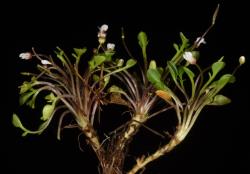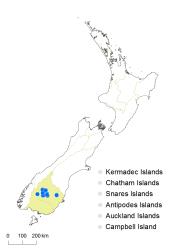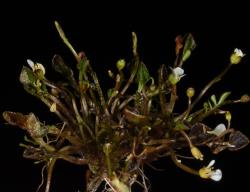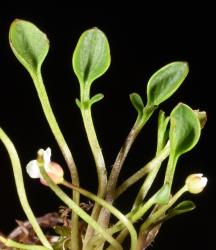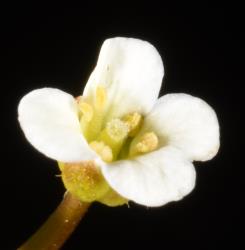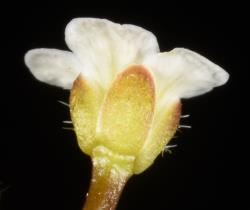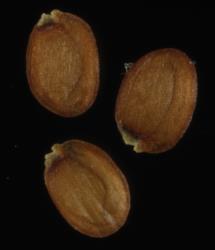Perennial herb, single rosette or with short lateral branches. Leaves up to 65 mm long, pinnatisect; lamina 3.0–13.0 × 1.5–7.0 mm, green, semi-coriaceous to coriaceous, glabrous or sparsely hairy on abaxial surface, glabrous or sparsely to moderately hairy on adaxial surface, margin and petiole; hairs 0.3–0.6 mm long, spreading to patent; petiole up to 52 mm long. Terminal pinna 3.0–11.0 × 1.5–8.0 mm, simple, orbicular-rhomboid, rhomboid, broadly elliptic-rhomboid to broadly elliptic; margin entire, with 1–4 distinct hydathodes; apex obtuse with a ± distinct hydathode; base obtuse to truncate. Lateral pinnae 1–8, 0.7–4.5 × 0.4–2.2, broadly elliptic-oblong to broadly elliptic-orbicular; apex obtuse; base obtuse; petiolule up to 0.2 mm long, or pinnae sessile. Cauline leaves absent. Inflorescence corymbose, each corymb 2–6-flowered or flowers solitary; peduncle up to 45 mm long, 0.5–1.3 mm diam. At base, spreading to ascending, glabrous to moderately hairy. Pedicels 6.0–70.0 mm long, 0.2–0.4 mm diam., glabrous to moderately hairy. Sepals 1.1–2.0 × 0.5–0.9 mm, elliptic-oblong, saccate, green to red-brown, usually glabrous to occasionally sparsely hairy, hairs spreading; margin white and membranous; apex obtuse; base truncate. Petals 1.3–3.5 × 0.9–2.2 mm, white, limb obovate, apex obtuse, base attenuate, tapering to a 0.2–0.4 mm long claw. Stamens 6; median filaments 4, 1.2–2.1 mm long; lateral filaments 2, 1.2–1.8 mm long; anthers 0.4–0.5 mm long, cream to pale yellow, when dehiscent held at a similar height to or slightly above the stigma. Ovary 0.8–1.8 mm long, 0.3–0.5 mm diam., ± terete, green, glabrous; ovules 16–22; style 0.1–0.2 mm long, ± terete; stigma 0.3–0.4 mm diam. Siliques 5.7–14.0 × 0.9–1.3 mm, glabrous, style 0.3–0.5 mm long; valves green to yellow-green and sometimes flushed purple at maturity and when dehiscent; replum 0.5–0.7 mm wide. Seeds 1.0–1.2 mm long, 0.9–1.0 mm wide, 0.3–0.4 mm thick, oblong-orbicular to broadly oblong, henna; wing absent.
Cardamine exigua is distinguished from C. reptans by its tufted growth habit and absence of spreading stems and rhizomes, the peduncles, pedicels and petioles usually having spreading to patent hairs, and smaller flowers with shorter sepals, petals, filaments and silique style.
Cardamine exigua is restricted to high alpine areas, where it occurs in a variety of habitats, including snowbanks, bogs, herbfields, and rock crevices.
Cardamine exigua is assessed as having a conservation status of At Risk—Naturally Uncommon, with the qualifier Data Poor (de Lange et al. 2018). The qualifier Data Poor is applied because additional information on the number and size of the populations is required.
Flowering November–February; Fruiting January–March.



